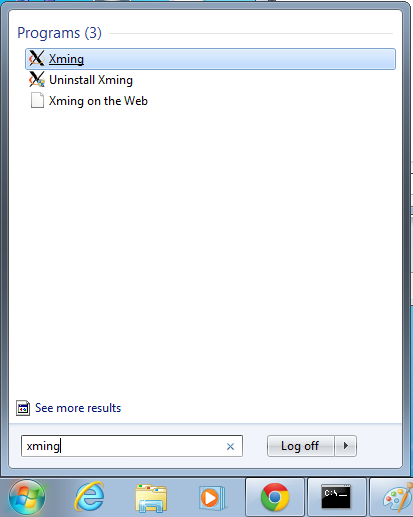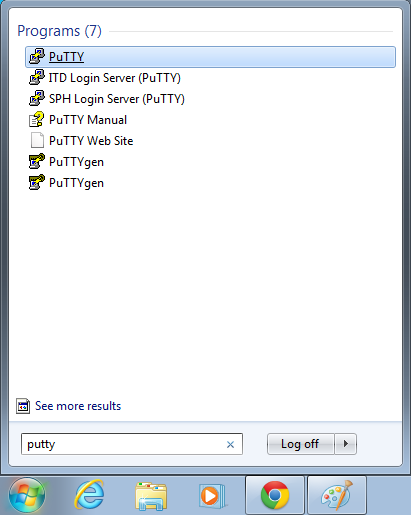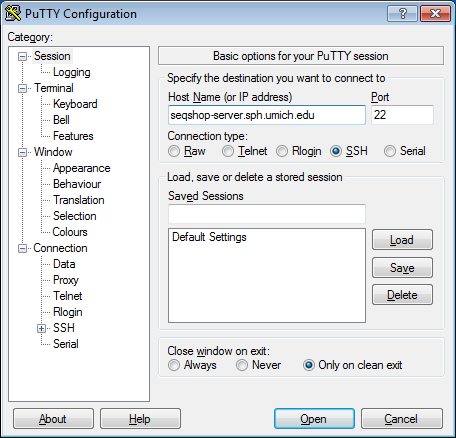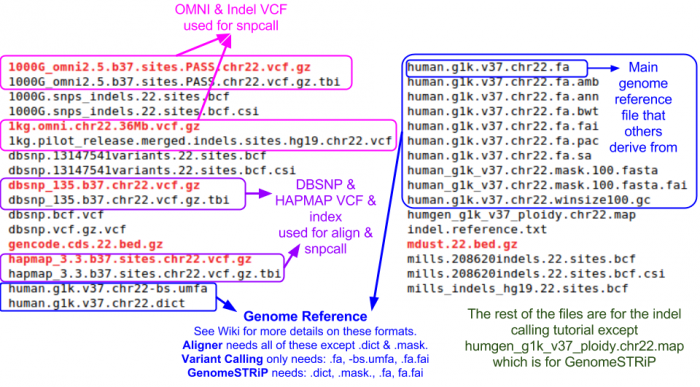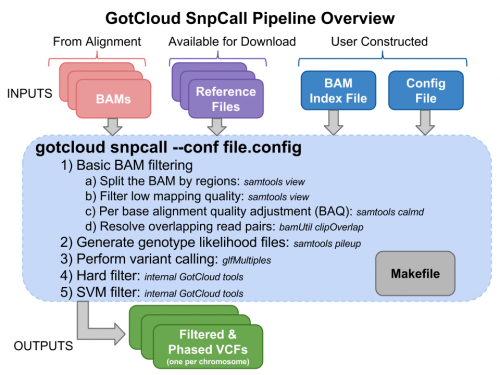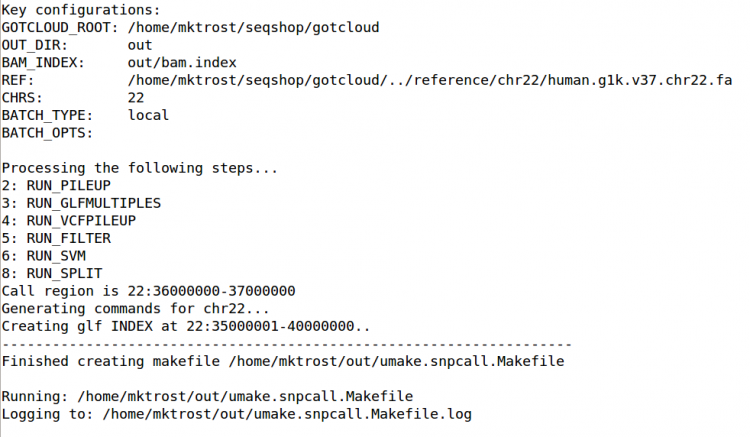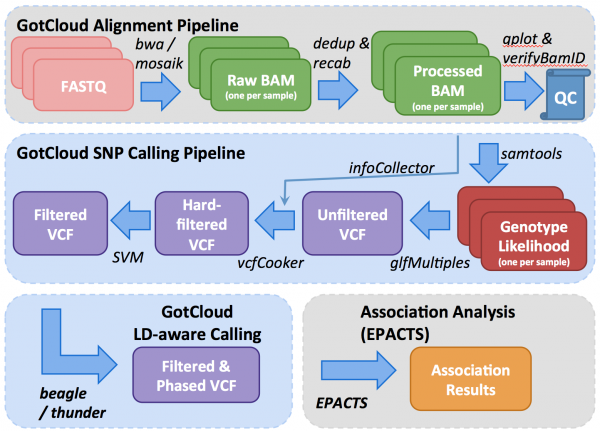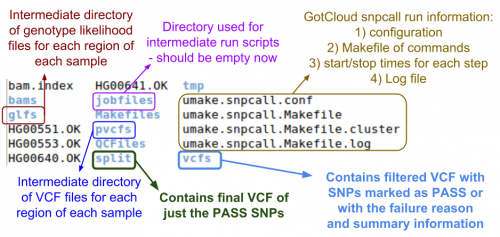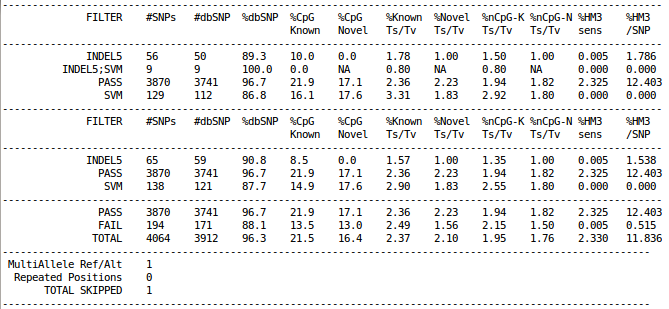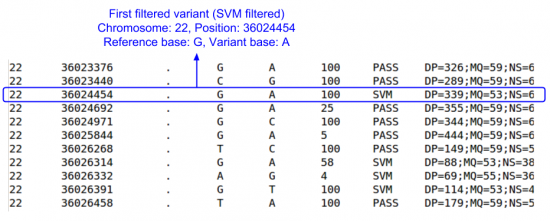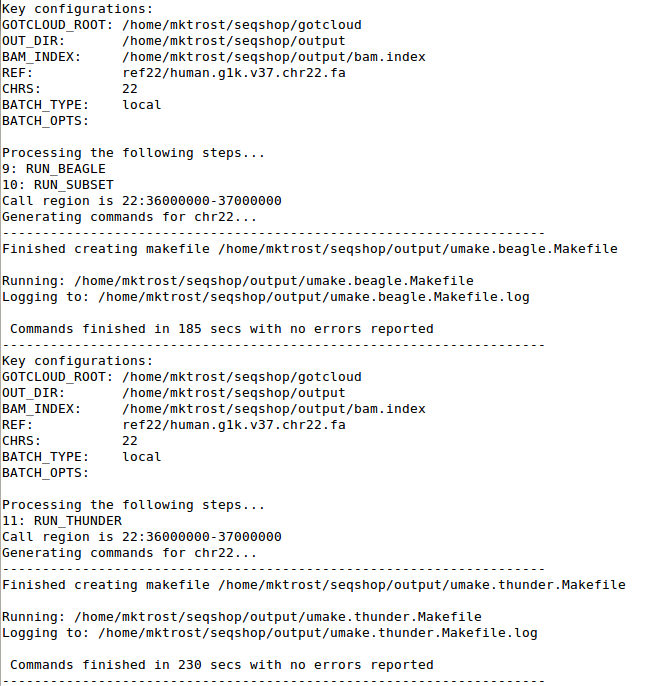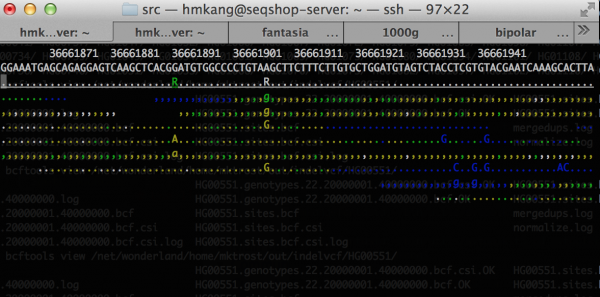Difference between revisions of "SeqShop: Variant Calling and Filtering for SNPs Practical, June 2014"
| Line 53: | Line 53: | ||
<div class="mw-collapsible-content"> | <div class="mw-collapsible-content"> | ||
| − | This tutorial builds on the alignment tutorial, if you have not already, please first run that tutorial: [[SeqShop:_Sequence_Mapping_and_Assembly_Practical|Alignment Tutorial]] | + | This tutorial builds on the alignment tutorial, if you have not already, please first run that tutorial: [[SeqShop:_Sequence_Mapping_and_Assembly_Practical, June 2014|Alignment Tutorial]] |
{{SeqShopRemoteEnv}} | {{SeqShopRemoteEnv}} | ||
| Line 61: | Line 61: | ||
Per sample BAM files contain sequence reads that are mapped to positions in the genome. | Per sample BAM files contain sequence reads that are mapped to positions in the genome. | ||
| − | For a reminder on how to look at/read BAM files, see: [[SeqShop:_Sequence_Mapping_and_Assembly_Practical#BAM_Files|SeqShop Aligment: BAM Files]] | + | For a reminder on how to look at/read BAM files, see: [[SeqShop:_Sequence_Mapping_and_Assembly_Practical, June 2014#BAM_Files|SeqShop Aligment: BAM Files]] |
For this tutorial, we will use the 4 BAMs produced in the [[SeqShop: Sequence Mapping and Assembly Practical, June 2014]] as well as with 58 BAMs that were pre-aligned to that 1MB region of chromosome 22. | For this tutorial, we will use the 4 BAMs produced in the [[SeqShop: Sequence Mapping and Assembly Practical, June 2014]] as well as with 58 BAMs that were pre-aligned to that 1MB region of chromosome 22. | ||
| Line 400: | Line 400: | ||
</ul> | </ul> | ||
| − | Let's take a look at that interesting location we found in the [[SeqShop:_Sequence_Mapping_and_Assembly_Practical#Accessing_BAMs_by_Position|alignment tutorial]] : chromosome 22, positions 36907000-36907100 | + | Let's take a look at that interesting location we found in the [[SeqShop:_Sequence_Mapping_and_Assembly_Practical, June 2014#Accessing_BAMs_by_Position|alignment tutorial]] : chromosome 22, positions 36907000-36907100 |
Use tabix to extract that from the VCFs: | Use tabix to extract that from the VCFs: | ||
Latest revision as of 14:37, 13 November 2014
Note: the latest version of this practical is available at: SeqShop: Variant Calling and Filtering for SNPs Practical
- The ones here is the original one from the June workshop (updated to be run from elsewhere)
Introduction
See the introductory slides for an intro to this tutorial.
Goals of This Session
- What we want to learn
- How to generate filtered variant calls for SNPs from BAMs
- Basic variant call file format (VCF)
- How to examine the variants at particular genomic positions
- How to evaluate the quality of SNP calls
Setup in person at the SeqShop Workshop
This section is specifically for the SeqShop Workshop computers.
If you are not running during the SeqShop Workshop, please skip this section.
Login to the seqshop-server Linux Machine
This section will appear redundantly in each session. If you are already logged in or know how to log in to the server, please skip this section
- Login to the windows machine
- The username/password for the Windows machine should be written on the right-hand monitor
- Start xming so you can open external windows on our Linux machine
- Start->Enter "Xming" in the search and select "Xming" from the program list
- Nothing will happen, but Xming was started.
- Open putty
- Start->Enter "putty" in the search and select "PuTTY" from the program list
- Configure PuTTY in the PuTTY Configuration window
- Host Name:
seqshop-server.sph.umich.edu - Setup to allow you to open external windows:
- In the left pannel: Connection->SSH->X11
- Add a check mark in the box next to
Enable X11 forwarding - Click
Open - If it prompts about a key, click
OK - Enter your provided username & password as provided
You should now be logged into a terminal on the seqshop-server and be able to access the test files.
- If you need another terminal, repeat from step 3.
Login to the seqshop Machine
So you can each run multiple jobs at once, we will have you run on 4 different machines within our seqshop setup.
- You can only access these machines after logging onto seqshop-server
3 users logon to:
ssh -X seqshop1
3 users logon to:
ssh -X seqshop2
2 users logon to:
ssh -X seqshop3
2 users logon to:
ssh -X seqshop4
Setup your run environment
This is the same setup you did for the previous tutorial, but you need to redo it each time you log in.
This will setup some environment variables to point you to
- GotCloud program
- Tutorial input files
- Setup an output directory
- It will leave your output directory from the previous tutorial in tact.
source /home/mktrost/seqshop/setup.txt
- You won't see any output after running
source- It silently sets up your environment
- If you want to view the detail of the setup, type
less /home/mktrost/seqshop/setup.txt
and press 'q' to finish.
Setup when running on your own outside of the SeqShop Workshop
This section is specifically for running on your own outside of the SeqShop Workshop.
If you are running during the SeqShop Workshop, please skip this section.
This tutorial builds on the alignment tutorial, if you have not already, please first run that tutorial: Alignment Tutorial
Setup your run environment
Environment variables will be used throughout the tutorial.
We recommend that you setup these variables so you won't have to modify every command in the tutorial.
- Point to where you installed GotCloud
- Point to where you installed the seqshop files
- Point to where you want the output to go
- Using bash (replace the paths below with the appropriate paths):
export GC=~/seqshop/gotcloud export SS=~/seqshop/example export OUT=~/seqshop/output
- Using tcsh (replace the paths below with the appropriate paths):
setenv GC ~/seqshop/gotcloud setenv SS ~/seqshop/example setenv OUT ~/seqshop/output
Examining GotCloud SnpCall Input files
Sequnce Alignment Files: BAM Files
Per sample BAM files contain sequence reads that are mapped to positions in the genome.
For a reminder on how to look at/read BAM files, see: SeqShop Aligment: BAM Files
For this tutorial, we will use the 4 BAMs produced in the SeqShop: Sequence Mapping and Assembly Practical, June 2014 as well as with 58 BAMs that were pre-aligned to that 1MB region of chromosome 22.
Reference Files
Reference files can be downloaded with GotCloud or from other sources.
- For this practical, I already downloaded them for you.
- See GotCloud: Genetic Reference and Resource Files for more information on downloading/generating reference files
For GotCloud snpcall, you need:
- Reference genome FASTA file
- Contains the reference base for each position of each chromosome
- Used to compare bases in sequence reads to the reference positions they mapped to
- Used to identify SNPs/variations in the sequence reads
- Additional information on the FASTA format: http://en.wikipedia.org/wiki/FASTA_format
- Contains the reference base for each position of each chromosome
- VCF (variant call format) files with chromosomes/positions
- indel - contains known insertions & deletions to help with filtering
- omni - used as likely true positives for SVM filtering
- hapmap - used as likely true positives for SVM filtering and for generating summary statistics
- dbsnp - used for generating summary statistics
We looked at them yesterday, but you can take another look at the chromosome 22 reference files included for this tutorial:
ls ${SS}/ref22
GotCloud BAM Index File
The BAM index file points GotCloud to the BAM files
- generated by the alignment pipeline
Look at the BAM index file the alignment pipeline generated
cat ${OUT}/bam.index
- What is the path to the BAM file for sample HG00640?
The alignment pipeline only processed 4 samples, but for snpcall, we want to run on 62 samples.
- The other 58 samples were already aligned:
ls ${SS}/bams
Look at the BAM index for those BAMs:
less ${SS}/bams/bam.index
Remember, use 'q' to exit out of less
q
- Do you notice a difference between this index and yours?
- Answer:
- It doesn't have a full path to the BAM file, while your index has /home/...
- That's ok, we will use the
--base_prefix ${SS}command-line option to prefix the BAM paths - Alternatively, we could have set BAM_INDEX in
gotcloud.confto the path to the BAMsBAM_INDEX = /home/username/seqshop/example
- NOTE: the conf file can't interpret ${SS} environment variables or '~', so you would have to specify the full path
- We just used the command-line option for this tutorial since this path will vary by user.
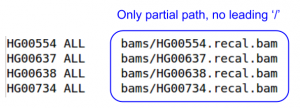
We need to add these BAMs to our index
- Append the bam.index from the pre-aligned BAMs to the one you generated from the alignment pipeline
- Be sure to do this command just once
cat ${SS}/bams/bam.index >> ${OUT}/bam.index
- ">>" will append to the file that follows it
- Check that your BAM index is the correct size
wc -l ${OUT}/bam.index
wc -lcounts the number of lines in the file- Should be 62
- Check that your BAM index is the correct size
Verify your BAM index contains the additional BAMs
less ${OUT}/bam.index
Remember, use 'q' to exit out of less
q
- Do you see both sets of BAMs?
GotCloud Configuration File
We will use the same configuration file as we used yesterday in GotCloud Align.
See SeqShop: Alignment: GotCloud Configuration File for more details
- Note we want to limit snpcall to just chr22 so the configuration already has
CHRS = 22(default was 1-22 & X).
For more information on configuration, see: GotCloud snpcall: Configuration File
- Contains information on how to configure for exome/targeted sequencing
Run GotCloud SnpCall
Now that we have all of our input files, we need just a simple command to run:
${GC}/gotcloud snpcall --conf ${SS}/gotcloud.conf --numjobs 4 --region 22:36000000-37000000 --base_prefix ${SS} --outdir ${OUT}
${GC}/gotcloudruns GotCloudaligntells GotCloud you want to run the alignment pipeline.--conftells GotCloud the name of the configuration file to use.- The configuration for this test was downloaded with the seqshop input files.
- --numjobs tells GotCloud how many jobs to run in parallel
- Depends on your system
- --region 22:36000000-37000000
- The sample files are just a small region of chromosome 22, so to save time, we tell GotCloud to ignore the other regions
--base_prefixtells GotCloud the prefix to append to relative paths.- The Configuration file cannot read environment variables, so we need to tell GotCloud the path to the input files, ${SS}
- Alternatively, gotcloud.conf could be updated to specify the full paths
--out_dirtells GotCloud where to write the output.- This could be specified in gotcloud.conf, but to allow you to use the ${OUT} to change the output location, it is specified on the command-line
This should take about 5 minutes to run.
- After about 4 minutes of running, GotCloud snpcall will output some text to the screen. Don't worry, that is expected and is just output from some of the intermediate tools.
- It should end with a line like:
Commands finished in 289 secs with no errors reported
If you cancelled GotCloud part way through, just rerun your GotCloud command and it will pick up where it left off.
If you want to understand more detailed step of GotCloud SNP calling, here is a schematic picture with a little bit more details
Examining GotCloud SnpCall Output
Let's look at the output directory:
ls ${OUT}
- Do you see any new files or directories?
Let's look at the vcfs directory:
ls ${OUT}/vcfs
Just a chr22 directory, so look inside of there:
ls ${OUT}/vcfs/chr22
- Can you identify the final filtered VCF and the associated summary file?
- Answer & annotated directory listing:
Now, let's look in the split directory for the VCF with just the passing variants:
ls ${OUT}/split/chr22
- Which file do you think is the one you want?
Filtering Summary Statistics
cat ${OUT}/vcfs/chr22/chr22.filtered.sites.vcf.summary
To understand how to interpret the filtering summary statistics, please refer to Understanding vcf-summary output
Filtered VCF
Let's look at the filtered sites file.
less -S ${OUT}/vcfs/chr22/chr22.filtered.sites.vcf
- Scroll down until you find some variants.
- Use space bar to jump a full page
- Use down arrow to move down one line
- Scroll right: lots of info fields, but no per sample genotype information
- What is the first filtered out variant that you find & what filter did it fail?
Remember, use 'q' to exit out of less
q
Now, let's look at the filtered file with genotypes.
zless -S ${OUT}/vcfs/chr22/chr22.filtered.vcf.gz
- Scroll down until you find some variants.
- Use space bar to jump a full page
- Use down arrow to move down one line
- Scroll right until you should see per sample genotype information
Remember, use 'q' to exit out of less
q
Passing SNPs
Let's look at the file of just the pass sites:
zless -S ${OUT}/split/chr22/chr22.filtered.PASS.vcf.gz
- Scroll down: they all look like they
PASS
Remember, use 'q' to exit out of less
q
Let's check if they are all PASS.
zcat ${OUT}/split/chr22/chr22.filtered.PASS.vcf.gz |grep -v "^#"| cut -f 7| grep -v "PASS"
It will return nothing since there are no non-passing variants in this file.
- Want an explanation of this command?
- zcat ...: uncompress the zipped VCF
- '|' : this takes the output of one command and sends it as input to the next
- grep -v "^#" : exclude any lines that start with "#" - headers
- cut -f 7 : extract the FILTER column (the 7th column)
- grep -v "PASS" : exclude any rows that have a "PASS" in the FILTER column
Compare that to the filtered file we looked at before:
zcat ${OUT}/vcfs/chr22/chr22.filtered.vcf.gz |grep -v "^#"| cut -f 7| grep -v "PASS"
- Do you see any filters?
- Answer
- Yes
- It should have scrolled and you should see filters like:
- INDEL5;SVM
- INDEL5
- SVM
- It should have scrolled and you should see filters like:
GotCloud Genotype Refinement
To improve the quality of the genotypes, we run a genotype refinement pipeline.
This pipeline runs Beagle & thunder.
Genotype Refinement Input
The GotCloud genotype refinement pipeline takes as input ${OUT}/split/chr22/chr22.filtered.PASS.vcf.gz (the VCF file of PASS'ing SNPs from snpcall).
The bam index and the configuration file we used for GotCloud snpcall will tell GotCloud genotype refinement everything it needs to know, so no new input files need to be prepared.
Note: the configuration file overrides the THUNDER command to make it go faster than the default settings so the tutorial will run faster:

Running GotCloud Genotype Refinement
Since everything is setup, just run the following command (very similar to snpcall).
${GC}/gotcloud ldrefine --conf ${SS}/gotcloud.conf --numjobs 2 --region 22:36000000-37000000 --base_prefix ${SS} --outdir ${OUT}
- Beagle will take about 2-3 minutes to complete
- Thunder will automatically run and will take another 3-4 minutes
Genotype Refinement Output
- What's new in the output directory?
- Answer
ls ${OUT}beagledirectory : Beagle outputthunderdirectory : Thunder outputumake.beagle.*: Contain the configuration & steps used in GotCloud beagleumake.thunder.*files : Contain the configuration & steps used in GotCloud thunder
Let's take a look at that interesting location we found in the alignment tutorial : chromosome 22, positions 36907000-36907100
Use tabix to extract that from the VCFs:
${GC}/bin/tabix ${OUT}/thunder/chr22/ALL/thunder/chr22.filtered.PASS.beagled.ALL.thunder.vcf.gz 22:36907000-36907100 |less -S
Remember, type 'q' to quit less.
q
- Are there any variants in this region?
- Answer:
- Yes!
- Positions:
36907001; Ref: T, Alt: C - that's what we saw before36907098; Ref: T, Alt: C - that's what we saw before
- What is HG00551's genotype at these positions?
- First check which sample number HG00551 is:
zcat ${OUT}/thunder/chr22/ALL/thunder/chr22.filtered.PASS.beagled.ALL.thunder.vcf.gz |grep "#CHROM"
- That will help you figure out it's genotype.
- Rerun the tabix command and scroll to find HG00551's genotype:
${GC}/bin/tabix ${OUT}/thunder/chr22/ALL/thunder/chr22.filtered.PASS.beagled.ALL.thunder.vcf.gz 22:36907000-36907100 |less -S
- Answer:
- It is the first sample
0|1: Heterozygous1|1; Homozygous Alt (C)
Remember, type 'q' to quit less.
q
Did I find interesting variants?
The region we selected contains APOL1 gene, which is known to play an important role in kidney diseases such as nephrotic syndrome. One of the non-synonymous risk allele, rs73885139 located at position 22:36661906 increases the risk of nephrotic syndrome by >2-folds. Let's see if we found the interesting variant by looking at the VCF file by position.
${GC}/bin/tabix ${OUT}/vcfs/chr22/chr22.filtered.vcf.gz 22:36661906 | head -1
Did you see a variant at the position?
${GC}/bin/tabix ${OUT}/vcfs/chr22/chr22.filtered.vcf.gz 22:36661906 | head -1
22 36661906 . A G 18 PASS DP=409;MQ=59;NS=62;AN=124;AC=2;AF=0.013827;AB=0.4065;AZ=-0.5287;
FIC=-0.0092;SLRT=-0.0075;HWEAF=0.0138;HWDAF=0.0276,0.0000;LBS=36,36,0,0,1,1,0,0;
OBS=145,191,0,0,3,2,0,0;STR=-0.040;STZ=-0.740;CBR=0.008;CBZ=0.144;IOR=0.000;IOZ=-1.370;
AOI=-5.614;AOZ=-4.243;LQR=0.178;MQ0=0.000;MQ10=0.000;MQ20=0.000;MQ30=0.000;SVM=1.51214
GT:DP:GQ:PL 0/0:4:28:0,12,65
Let's check the sequence data to confirm that the variant really exists
${GC}/bin/samtools tview ${SS}/bams/HG01242.recal.bam ${SS}/ref22/human.g1k.v37.chr22.fa
- Type 'g' to go to a specific position
- Type 22:36661906 to move to the position
- Press arrows to move between positions
- Press 'b' if you want to color by base quality
- Press '?' for more help
Improvements
Let's get some information on the BEAGLE VCF:
perl ${SS}/ext/bed-diff.pl --vcf1 ${SS}/ref22/1kg.omni.chr22.36Mb.vcf.gz --vcf2 ${OUT}/beagle/chr22/chr22.filtered.PASS.beagled.ALL.vcf.gz --gcRoot ${GC} --out ${OUT}/bedDiff.beagle
Look at the results:
more ${OUT}/bedDiff.beagle.summary
- Results
OVERALL: 43601 44293 0.9844 NREF-EITHER: 19667 20359 0.9660 NMAJ-EITHER: 14585 15277 0.9547
HOMREF: 23934 100 1 0.9958 HET: 329 11959 175 0.9596 HOMALT: 4 83 7708 0.9888
HOMMAJ: 29016 126 2 0.9956 HET: 364 11959 140 0.9596 HOMMIN: 3 57 2626 0.9777
Now, let's see if it improved after running Thunder VCF:
perl ${SS}/ext/bed-diff.pl --vcf1 ${SS}/ref22/1kg.omni.chr22.36Mb.vcf.gz --vcf2 ${OUT}/thunder/chr22/ALL/thunder/chr22.filtered.PASS.beagled.ALL.thunder.vcf.gz --gcRoot ${GC} --out ${OUT}/bedDiff.thunder
Look at the results:
more ${OUT}/bedDiff.thunder.summary
- Results
OVERALL: 43685 44293 0.9863 NREF-EITHER: 19758 20366 0.9701 NMAJ-EITHER: 14688 15296 0.9603 HOMREF: 23927 106 2 0.9955 HET: 286 12057 120 0.9674 HOMALT: 6 88 7701 0.9879 HOMMAJ: 28997 144 3 0.9950 HET: 286 12057 120 0.9674 HOMMIN: 5 50 2631 0.9795
There is an improvement.
What is GotCloud snpcall doing?
To run GotCloud, you really just needed a single command.
Well, that one command runs many steps. Here is a diagram of all the steps.
Aren't you glad you didn't have to configure & run each one yourself?
